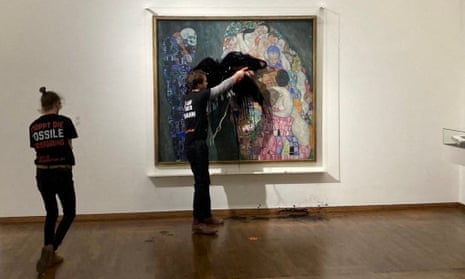Another day, another gallery: the attacks on art in the name of climate action have become a headline-hogging obsession with a hideous escalating logic. The nastier the treatment a famous masterpiece gets, the bigger the media coverage.
Now, members of Letzte Generation Österreich (Last Generation Austria) have smeared “non-toxic fake oil” all over the glass covering of Gustav Klimt’s Death and Life, a colouristic vision of pink and gold intertwined human bodies menaced by the grim reaper. Not that you can see much of that in the disturbing images of the attack at the Leopold Museum in Vienna: a black and purple stain all but obscures the delicate picture. The aggression of the attack takes this wave of action a step further than tomato soup on Vincent van Gogh’s Sunflowers and mashed potato on a Monet. But a step further to where?
There’s no chance of governments changing their policies because of these protests. There’s every chance, however, that a great work of art will eventually be destroyed.
The action in Vienna makes that horribly obvious. This is iconoclasm. There’s a deliberate flirtation with destroying art, an implicit threat to go all the way, which expresses contempt for art and the museums that try to conserve and protect it.
I can’t pretend to respect this form of protest. It makes no sense and possesses no moral coherence. It is arrogant to go into a museum and assume everyone around you is some kind of complacent aesthete who doesn’t care about the environment. “What is worth more? Art or life?” asked the Just Stop Oil activists who threw the tomato soup at Van Gogh’s Sunflowers. What a ridiculously false debate. Loving art does not devalue life – on the contrary, it helps us value and see nature. All the art in the National Gallery in London, where the soup attack happened, from Giotto to Van Gogh, is based on looking hard at life. It praises our planet.
John Constable’s The Haywain got papered over in one of the first attacks by Just Stop Oil this summer, yet Constable was a critic of the industrial revolution. He painted chimneys darkening the sky with carbon in his canvas, The Opening of Waterloo Bridge. The same romantic love of nature that breathes in his paintings inspired the 19th-century art critic John Ruskin to champion the natural world as well as social justice.
But the art attackers don’t appear to display any interest in the content or purpose of the masterpieces they bully. Instead, they seem entirely alien from the art itself.
Attacking “iconic” art gets attention and purportedly causes a debate. Yet, the only debate here is one about protest. I am yet to see evidence of renewed thought or sensitivity about the climate crisis. Instead, they spawn articles like this about the rights and wrongs of the act. Dramatic gestures in museums do not express and heal the pain of the planet, collective action does. That has to be based on democratic agreement, not coercion by a man with a petrol bomb standing by Picasso’s Guernica. Which is where we appear to be heading.
Do we really want to go any further into a realm where any work of art is fair game in the name of a higher cause?
The Leopold Museum got sponsorship from an oil and gas company for free entry on the day of the attack. The relationship between the art world and the oil industry is one that must be addressed. However, this is not the fault of Klimt. He worked for largely Jewish clients at the start of the 20th century, painting sensual visions of strong women and celebrating love. He was not known in his creative and passionate life as a champion of big oil, nor did he contribute in any great way to the climate emergency. There is no reason on earth to single out his art for a climate protest.
The climate protesters should know that there is an unfortunate precedent for the sabotage of Klimt’s loving, tender paintings. In 1945, in the wake of Hitler’s death, an SS unit set fire to a castle in the south of Austria containing some of his greatest works and destroyed them for ever.
Death and Life, the Klimt painting is called. Those who attacked it think they are fighting for the latter, but they could well be fighting for the death of art itself.
Jonathan Jones writes on art for the Guardian

